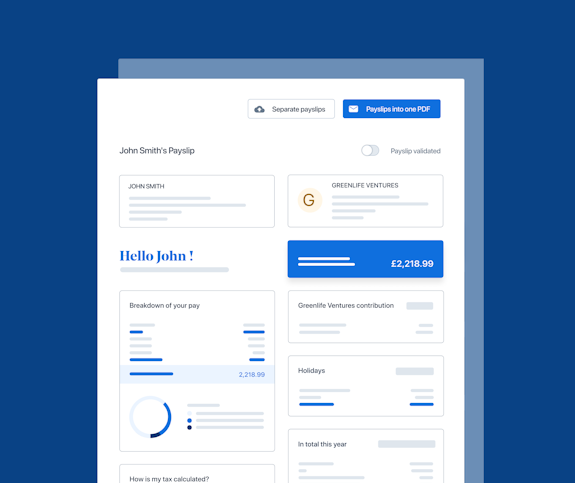- Blog
- |Managing Payroll
- >Payroll
- >payroll errors what to do
So You Made a Payroll Mistake: Here's What to Do About It


Mistakes happen in business, but mistakes in your payroll, specifically, can cause unnecessary stress for your HR and finance teams. Payroll errors impact the employee experience and can mean the difference between employees staying or leaving your business.
Building trusting relationships with your employees means better productivity, which means the company performs better - it’s as simple as that. So minimising common payroll mistakes should be a business priority.
Whether you’re currently in the wake of a payroll mistake or wondering how to handle (or avoid) one in the future, this blog is here to help guide you through how to manage payroll errors and improve payroll accuracy going forward.
Firstly, who is responsible for payroll errors?
When you make a payroll mistake, the first thing you feel is probably a cold wave of panic. After all, payroll mistakes can leave employees struggling to pay their bills and can also damage the trust between employer and employee. But try not to worry; mistakes happen.
So where does the responsibility lie for these mistakes? Well, that depends on the error.
Unfortunately, the first port of call for any mistakes concerning employees will be to the payroll department — even if the error was caused by incorrect data shared with the payroll team.
So even if the error stems from bad data, i.e. a manager forgets to log an employee’s sickness, or HR forgets to tell payroll about a new starter, payroll has to deal with the blame. If the error is due to manual data entry, this is a mistake that sits with whoever processes the payroll.
Regardless of who is at fault for the mistake, Payroll has a duty to implement processes to facilitate better data sharing — i.e. you need one place for HR to submit starters to payroll. In this instance, if HR doesn’t follow the set process, whoever is running payroll has something to fall back on.
Being able to spot the source of errors, particularly repeated ones, can help you pinpoint areas where additional staff training can help eliminate them altogether.
How to communicate a payroll error
60% of employees say they’ve encountered errors on their payslips — so, if you’ve made a payroll mistake, don’t worry, you’re not alone!
And although many employees have spotted mistakes, the good news is that most people who run payroll have an accuracy rate of 97%. If you do happen to creep into the 3% error rate, it can cause unnecessary stress for everyone involved in your HR and finance teams.
Whether you’ve misclassified workers, underpaid workers, lost important payroll data or missed an HMRC deadline, you’ll want to own up to your mistake and put processes in place to ensure it doesn’t happen again.
But how do you broach this process?
Firstly, be transparent from the outset. Communicate exactly what the mistake is and how it affects your employees — don’t forget to apologise and give employees a chance to ask questions. After all, the mistake directly affects them and their money.
Next, you’ll need to communicate the error with employees in a formally-written letter. This letter should detail the mistake and re-iterate how it affects your employees. You’ll want to disclose how this mistake happened and how you plan to stop it from happening again — e.g. additional staff training, upgrading your payroll software etc.
Being transparent with employees can help fix any damage to the relationship and reinforce trust between you. In addition, making sure employees are well-informed about any errors and updates to processes will ensure you keep this relationship intact going forward.
How can payroll accuracy be improved (and fix errors)
Improving the accuracy of your payroll should be a priority for your business because improving accuracy ultimately equates to fewer errors. But where do you start?
You’ll want to act on the mistake as soon as you notice it. That might mean cancelling the payroll and reprocessing it or planning changes to counteract the previous mistakes in the next payroll.
Here are five ways you can improve payroll accuracy:
Improve staff training
If the same mistakes are made by the same people each payroll cycle, it’s time for some additional training. It’s your job to ensure staff are confident in updating their expense reports or reporting team over time.
Wherever the errors occur, pinpoint the problem and offer mandatory training to close those knowledge gaps.
Level up payroll communication
We’ve eluded to this above, but clear communication is the answer to many mistakes made in the workplace. Whether people assume details incorrectly or don’t want to ask for help, clear communication can help in these circumstances. Communicate what you need from them, by when and why it’s essential.
As soon as they realise it could affect their pay, they might be pretty swift with sharing the correct payroll data!
Keep up to date with payroll legislation
A large part of keeping payroll mistakes at bay is understanding what’s required of you. For example, what do you need to submit to HMRC? What are the penalties/consequences for late submission and missed deadlines?
Understanding the nuances of payroll legislation is crucial to remaining payroll compliant — avoiding fines and penalties and saving yourself the stress and wasted time re-submitting previously incorrect data.
Integrate your systems
Having a centralised system where data is synced and stored means you can wave goodbye to duplicate payroll data — removing the need for manual data entry. Manual data entry wastes time and increases the chances of human error.
Find a payroll software into which you can plug other tools from across your stack to get a clearer picture of your data.
Consider investing in automated payroll software
Payroll can be time-consuming — particularly if you have a limited payroll and HR team, but that’s where payroll software comes in handy.
And we’re not just suggesting this because we are an automated payroll software solution… but investing in payroll software saves you time, improves accuracy and improves the employee experience. How?
by automating menial and time-consuming payroll tasks
by empowering employees with access to transparent payslips
by ensuring you meet all HMRC deadlines
by automating pension submissions
How can PayFit help your business improve its payroll processes? Schedule a quick demo or watch this demo video to see what we can do for your company.


A UK 4-Day Working Week - Thoughts On Labour’s Plan

Running payroll - A Guide For New Businesses

The Alabaster Ruling & Maternity Pay - A Guide For Employers

The End Of Zero Hours Contracts? Implications For Businesses

What is the HM Revenue and Customs Starter Checklist

